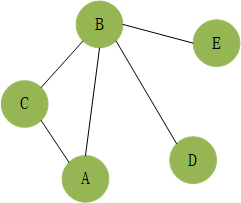
| A | B | C | D | E | |
| A | 0 | 1 | 1 | 0 | 0 |
| B | 1 | 0 | 1 | 1 | 1 |
| C | 1 | 1 | 0 | 0 | 0 |
| D | 0 | 1 | 0 | 0 | 0 |
| E | 0 | 1 | 0 | 0 | 0 |
// explain
//1 indicates that it can be connected directly, and 0 indicates that it cannot be connected directly
Depth first search process:
A-B-C-D-E,A, B and C can be connected, and the connection is "1"; B is connected with a, C, D and E; C is connected with a and B; D and B connect, e and B connect.
A connects to B. after finding B, B connects to C. C can't connect to other nodes, so it returns to B, B connects to D and B connects to E. (when you find a point, it doesn't change, and one road goes to black).
code:
/Get the subscript of the first node
public int getfirstNeighbor(int index){
for(int j=0;j<vertexList.size();j++){
if(edges[index][j]>0){
return j;
}
}
return -1;
}
//The next adjacent node is obtained according to the subscript of the previous adjacent node
public int getNextNeighbor(int v1,int v2){
for(int j=v2+1;j<vertexList.size();j++){
if(edges[v1][j]>0){
return j;
}
}
return -1;
}
//Depth first traversal
/* isVisited[] An array that records whether a node accesses
* i The first time is 0
*/
public void dfs(boolean[] isVisited,int i){
//First access the node and output
System.out.print(getValueByIndex(i)+"->");
isVisited[i]=true;
int w=getfirstNeighbor(i);
while(w!=-1){
//Indicates that there are adjacent nodes
if(!isVisited[w]){
dfs(isVisited,w);
}
//If the node is accessed
w=getNextNeighbor(i,w);
}
}
//Overloaded dfs method
public void dfs(){
isVisited=new boolean[vertexList.size()];
//Traverse all nodes for dfs backtracking
for(int i=0;i<vertexList.size();i++){
if(!isVisited[i]){
dfs(isVisited,i);
}
}
}2, Breadth first traversal of graphs (BFS)
The basic idea of breadth first traversal is similar to a hierarchical search process. A queue needs to be used to maintain the order of visited nodes, so as to access the leading nodes of these nodes in this order.
Algorithm steps:
1 access the initial node v and mark that node v has been accessed
2 node v in queue
3 when the queue is not empty, continue to execute, otherwise the algorithm will end
4. Get out of the queue and get the queue head node u
5 find the first collar node v of node u
6 if the collar node w of node u does not exist, move to step 3, otherwise cycle through the following three steps
6.1 if node w has not been accessed, access node W and mark it as accessed
6.2 node w in queue
6.3 find the next collar node after the w collar node of node u and transfer to step 6
The search process is as follows:
A finds B and then finds the successor node C of B. A can find C. at this time, B pops up B in the queue and finds it from node B. at this time, node a has been accessed, and C has also been accessed. At this time, D has been accessed, and E can also be accessed

That is, B and C are accessed by A, and D and E are accessed by A node.
//breadth-first search
public void bfs(boolean isVisited[],int i){
int u; //Indicates the subscript corresponding to the head node of the queue
int w; //Adjacency node
//Queue, which records the order of accessing nodes
LinkedList queue=new LinkedList();
//Output access node information
System.out.println(getValueByIndex(i)+"->");
//Mark as accessed
isVisited[i]=true;
//Add an accessed node to the queue
queue.addLast(i);
while(!queue.isEmpty()){
//Fetch the subscript of the header node of the queue
u=(Integer)queue.removeFirst();
//Get the subscript of the first adjacent node
w=getfirstNeighbor(u);
while(w!=-1){
//Have you visited
if(!isVisited[w]){
System.out.println(getValueByIndex(w)+"->");
//Mark as accessed
isVisited[w]=true;
//Join the team
queue.addLast(w);
}
//Take u as the leading point and find the next node after w
w=getNextNeighbor(u,w);
}
}
}
//Traverse all nodes and perform breadth first search
public void bfs(){
isVisited=new boolean[vertexList.size()];
for(int i=0;i<vertexList.size();i++){
if(!isVisited[i]){
bfs(isVisited,i);
}
}
}get!